The content of the article
Inhalations that are carried out using a nebulizer are different from ordinary varieties of boiled potatoes or essential oils. The device allows you to adjust the size of the sprayed particles and the depth of penetration of the drug. Electric inhalers disinfect and warm the infected tissues of the bronchi, larynx and lungs. They dilute sputum and accelerate recovery, but only with proper use.
Solutions: indications and contraindications
The nebulizer is used for the common cold, which is accompanied by a cough, and pharyngitis of a viral or allergic type. Steam penetrates the alveoli, diluting mucus and removing sputum. Facilitates the purulent secretion and reduces inflammation. Only special means that the doctor selects are poured into the electric inhaler. The specialist may prescribe:
- The course of antibacterial medicines, if bronchitis occurs with complications, as well as antibiotics.
- Hormonal drugs. Glucocorticosteroids relieve severe inflammation and strengthen the immune system.
- Expectorant solutions and mucolytics. They are recommended for wet and dry coughs. Inhalations by such means reduce the viscosity of purulent secretion, help the body clear itself of mucus.
- Antihistamine solutions. Prescribed for allergic cough. Assign to patients with asthma. Means suppress the production of substances responsible for inflammation, relieve swelling of the bronchi and larynx.
- Antitussive. Funds are prescribed for laryngeal edema, laryngitis, bronchospasm and allergies. Medications soothe sore and swollen mucous membranes, soothe dry coughs.
- Bronchodilators. They help with asthma attacks and protect against asthma, remove chronic lung diseases.
It is forbidden to introduce solutions from hard tablets or cough syrups into the device. Home remedies clog the nebulizer tube and damage the device.
Solutions of essential oils cannot be injected into electronic and ultrasonic inhalers. The components stick to the alveoli and create a film. The body cannot cleanse the respiratory system of the oily layer, the inflammation intensifies, and ordinary bronchitis turns into pneumonia.
Essential oils not only harm health, but also remain on the tube and other parts of the device, reduce its life.
Herbal decoctions are not poured into the nebulizer. In water and alcohol tinctures of home-made microparticles of plants remain. Pieces of dried leaves, stems and pollen settle on the mucous membrane of the lungs and injure the alveoli. The inflammatory process is exacerbated, the patient's well-being worsens with each new inhalation.
Instead of homemade decoctions, alcohol pharmacy tinctures from propolis and calendula, as well as Chlorophyllipt and Rotokan are used. They are recommended for colds and dry coughs. Means containing alcohol are contraindicated in children. Alcohol causes intoxication of the body and worsens the well-being of a small patient.
Do not recommend the use of drugs that do not interact with the mucous membrane of the lungs and bronchi. These include Diphenhydramine, Papaverine, and Eufillin.
A doctor should choose the means for the preparation of solutions. Some drugs cannot be combined. For example, mucolytics with antitussive or antibiotics with hormonal.
If it is not possible to consult a doctor, mineral water is used for inhalation. Children are advised to buy saline. Sterile fluid softens the mucous membrane and flushes out sputum, making coughing easier and relieving cramping.
Dosage and duration
At one time, the patient uses 3-4 ml of the solution. Expectorant and hormonal drugs, mucolytics and antibiotics are diluted with mineral water. A bottle with a liquid base is opened and waiting for all the bubbles to come out. Then the workpiece is heated to 20 degrees and introduced into a special container. For inhalation, they buy special mineral water. Such therapeutic options as Narzan and Borjomi, as well as Essentuki are suitable. Drugs intended for the treatment of cough in a child are diluted with saline.
The duration of the first procedure is 3-4 minutes. After it, you may feel dizzy or cough. Some patients experience nausea. Symptoms appear due to hyperventilation of the lungs. When the patient learns to properly inhale and exhale fumes, dizziness and other side effects will cease to bother him.
The duration of one procedure is gradually increased to 5 minutes, and then to 10. During the day, 2 to 6 inhalations are carried out with interruptions of 1.5–3 hours.
With a strong cough, it is recommended to use a nebulizer in several stages:
- First, inhale saline or mineral water to moisten the mucous membrane of the nasopharynx and bronchi. Vapors thin the purulent secretion and stimulate expectoration of sputum.
- Bronchi in 2-3 hours will be cleared of mucus and prepared for the second stage. Now, a solution with antibiotics or anti-inflammatory drugs is injected into the nebulizer chamber.
Mineral water or heated saline solution is poured into a cup of an electric inhaler. Use a sterile syringe with a clean needle. Then, a drug for bronchitis or a runny nose is added to the liquid base.
If a nebulizer is used to prevent influenza and colds, a special container is filled with sodium chloride or mineral water. No tinctures and antibiotics. Inhalations are carried out 1 time per day. The device is used after an evening walk, return from the garden, school or work.
Features of the procedure
A nebulizer does not treat a common cold. Electric inhaler is designed to combat rhinitis, which is accompanied by cough, tonsillitis and bronchitis, as well as asthma, allergic and viral pharyngitis.
Adults and young patients are carefully prepared for the procedure. 1.5–2 hours before inhalation, they are densely fed to prevent dizziness. But the nebulizer is not used on a full stomach, otherwise nausea or even vomiting will appear.
The throat and nasal passages are washed with saline or broth, cleansing of accumulated pus. Mucus worsens the absorption of drugs. Rinse is carried out 1.5 hours before inhalation. Wash the mask or nebulizer tube with antibacterial agents. A special solution is replaced with fifteen percent soda.
Inhalation is carried out in a warm room. The patient puts on a loose T-shirt or sweatshirt that does not fit the chest and abdomen too much. During the procedure, you need to take deep breaths. Close clothing interferes and causes discomfort.
Do sports at least an hour before inhalation. Before using the nebulizer, it is forbidden to run, jump, swim and do exercises. Children should not play games that are too mobile. Small and adult patients are advised to lie down and relax before the procedure to normalize breathing and calm the heartbeat.
Inhalation with a nebulizer is carried out in an upright position. In adults, there are no problems with the fulfillment of this condition, and small patients begin to be capricious and refuse to sit still for 10 minutes. They spin, try to jump up, scream and break out. A TV or tablet with your favorite cartoons helps to calm and distract the child.
Infants from 6–7 months of age who cannot sit on the sofa or armchair on their own should be supported by parents. If you use a nebulizer when the child is in a horizontal position, breathing and lung problems will occur.
An adult sits the baby on the edge of a chair or bed, hugs the baby legs with his lower limbs, and holds the upper body with his right or left hand. The second holds a pipe or mask, which he is leaning against his face. It will be more convenient if the baby rests its back on the stomach of mom or dad.
While one parent is engaged in a nebulizer, the second distracts the child: makes faces, shakes a rattle, or turns on cartoons on the tablet. If the baby is frightened and cries badly, the inhalation is canceled, otherwise the hot air will provoke spasms in the bronchi and an attack of suffocation.
How to breathe
To the device, filled with a solution, connect a tube with a mask or mouthpiece. With rhinitis, nasal cannulas are used. The nebulizer is checked before switching on. The spray chamber should stand straight. The medicine compartment lid is tightly closed and airtight.
The inhaler is connected to the mains. Cannulas are inserted into the nasal passages, and the mouthpiece is inserted into the mouth. The mask is pressed to the lower half of the face. In rhinitis, the vapors are inhaled and exhaled by the nose. Drugs enter the mucous membrane of the nasopharynx and the maxillary sinuses.
With bronchitis and lung diseases, couples gain mouth. Slowly draw in hot air, hold their breath for 2-3 seconds and empty the chest. You can push carbon dioxide through your nose or mouth, but do it smoothly and without sudden jerks. Talking during inhalation is prohibited. Immediately after the procedure, you can not jump from the couch or go outside. The patient is recommended to lie down for 30-40 minutes under a rug in a warm room with closed windows. The body will rest, and breathing will normalize.
Hygiene procedures
After inhalation, the patient wipes his face with a soft cloth. If solutions of antibiotics or corticosteroids were poured into the nebulizer, the throat and nasal passages are washed with boiled water with salt or soda.
Before inhalation, hands and face are washed with antibacterial soap. Microbes cannot get on the mask or mouthpiece. The syringe, which was injected with mineral water and the drug into the nebulizer, is immediately discarded after the procedure.
Contraindications
- Any inhalation can not be carried out at a temperature of 37.5 degrees and above.
- The nebulizer is not used for arrhythmias, tachycardia, cerebral atherosclerosis, heart failure and hypertension. The procedure is prohibited if the patient has suffered a heart attack or stroke.
- Steam inhalations are contraindicated in case of spontaneous pneumothorax, respiratory failure of the 3rd degree and bullous emphysema.
- Nebulizer is not recommended to treat cough and sore throat with regular nosebleeds.
After the procedure, 1–1.5 hours, you can’t eat and smoke, do physical education.
An electric inhaler is a useful and convenient device. When used correctly, it will replace cough syrups and antibiotics, will save parents from endless children's colds and sick leave. The nebulizer will strengthen the child’s immunity, protect it from pneumonia, bronchial asthma and other serious complications.
Video: inhalation with a nebulizer for bronchitis

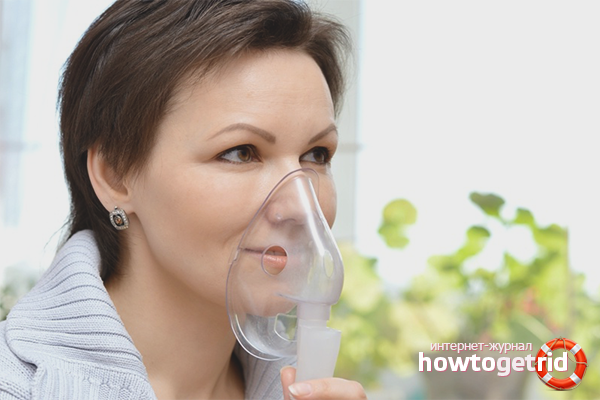
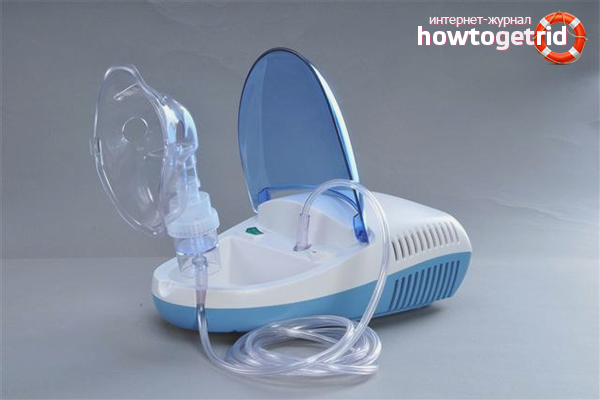
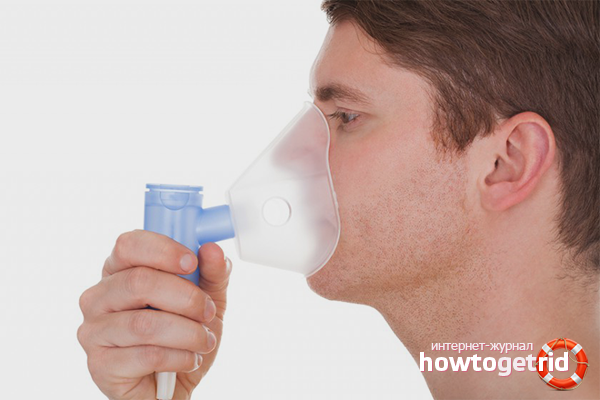
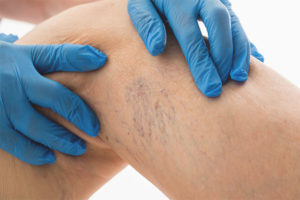
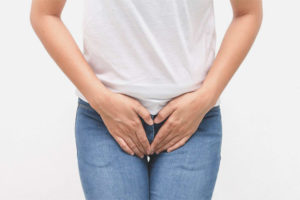
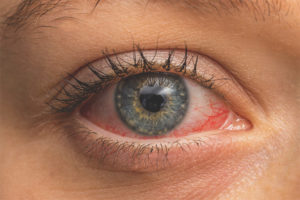

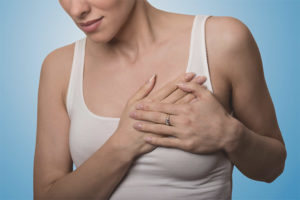



Submit